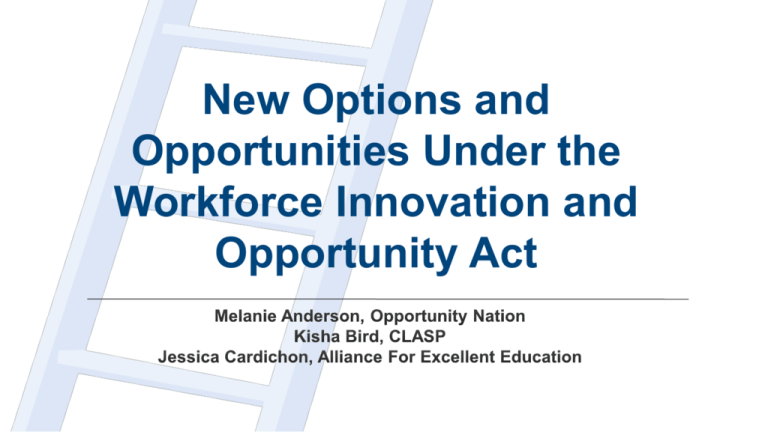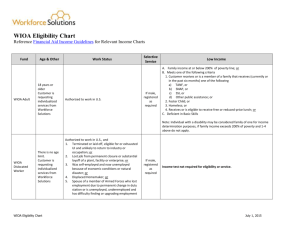WIOA - Alternative Accountability Policy Forum
advertisement

New Options and Opportunities Under the Workforce Innovation and Opportunity Act Workforce Investment Act Signed into law in 1998 Five Titles Title I. Workforce Investment Systems Title II. Adult Education and Literacy Title III. Workforce Investment-Related Activities and Wagner-Peyser Act Title IV. Rehabilitation Act Amendments of 1998 Title V. General Provisions $3 billion program Main Formula Programs Adults – individuals over the age of 18 with barriers to employment Dislocated Workers – individuals who have been laid off or received notice of termination of employment, are eligible for or have exhausted unemployment compensation, are self-employed but unemployed because of general economic conditions, or are displaced homemakers Youth – low-income individuals between 14-21 years of age7 who meet at least one of several conditions Path Towards Reauthorization – House passed SKILLS Act in April 2013 – Senate HELP Committee passed the Workforce Investment Act of 2013 – Workforce Innovation and Opportunity Act • U.S. House of Representatives passed on July 9, 2014 with a 415-6 vote • U.S. Senate passed on June 25, 2014 with a 95-3 vote • President Obama signed on July 22, 2014 Key Provisions of WIOA Increases the focus on serving the most vulnerable workers—lowincome adults and youth Expands education and training options to help participants access good jobs and advance in their careers Helps disadvantaged and unemployed adults and youth earn while they learn Aligns planning and accountability policies across core programs to support more unified approaches Brief WIOA Overview For more details see CLASP Summary: New Opportunities to Improve Economic and Career Success for Low-Income Youth and Adults: Key Provisions of the Workforce Innovation and Opportunity Act (WIOA) - http://www.clasp.org/resources-and-publications/publication1/KeyProvisionsofWIOA-Final.pdf 7 Prioritize Services to Out-of-school Youth & Vulnerable Low-income Adults 9 Prioritize Services to Out-of-school Youth & Vulnerable Low-income Adults 10 New and Expanded Definitions 11 Basic Skills Deficient WIA WIOA BASIC SKILLS DEFICIENT.—The term ‘‘basic skills deficient’’ means, with respect to an individual, that the individual has English reading, writing, or computing skills at or below the 8th grade level on a generally accepted standardized test or a comparable score on a criterion-referenced test. The term ‘‘basic skills deficient’’ means, with respect to an individual— (A) who is a youth, that the individual has English reading, writing, or computing skills at or below the 8th grade level on a generally accepted standardized test; or (B) who is a youth or adult, that the individual is unable to compute or solve problems, or read, write, or speak English, at a level necessary to function on the job, in the individual’s family, or in society. 12 Low-Income Individual WIA WIOA LOW-INCOME INDIVIDUAL.—The term ‘‘low-income individual’’ means an individual who— (A) receives, or is a member of a family that receives, cash payments under a Federal, State, or local income based public assistance program; (B) received an income, or is a member of a family that received a total family income, for the 6-month period prior to application for the program involved (exclusive of unemployment compensation, child support payments, payments described in subparagraph (A), and old-age and survivors insurance benefits received under section 202 of the Social Security Act (42 U.S.C. 402)) that, in relation to family size, does not exceed the higher of— (i) the poverty line, for an equivalent period; or (ii) 70 percent of the lower living standard income level, for an equivalent period; The term ‘‘low-income individual’’ means an individual who— (i) receives, or in the past 6 months has received, or is a member of a family that is receiving or in the past 6 months has received, assistance through the supplemental nutrition assistance program established under the Food and Nutrition Act of 2008 (7U.S.C. 2011 et seq.), the program of block grants to States for temporary assistance for needy families program under part A of title IV of the Social Security Act (42 U.S.C. 601 et seq.), or the supplemental security income program established under title XVI of the Social Security Act (42 U.S.C. 1381 et seq.), or State or local income-based public assistance; (ii) is in a family with total family income that does not exceed the higher of— (I) the poverty line; or (II) 70 percent of the lower living standard income level; 13 Low-Income Individual WIA WIOA (C) is a member of a household that receives (or has been determined within the 6-month period prior to application for the program involved to be eligible to receive) food stamps pursuant to the Food Stamp Act of 1977 (7 U.S.C. 2011 et seq.); (D) qualifies as a homeless individual, as defined in subsections (a) and (c) of section 103 of the Stewart B. McKinney Homeless Assistance Act (42 U.S.C. 11302); (E) is a foster child on behalf of whom State or local government payments are made; or (F) in cases permitted by regulations promulgated by the Secretary of Labor, is an individual with a disability whose own income meets the requirements of a program described in subparagraph (A) or of subparagraph (B), but who is a member of a family whose income does not meet such requirements. (iii) is a homeless individual (as defined in section 41403(6) of the Violence Against Women Act of 1994 (42 U.S.C. 14043e–2(6))), or a homeless child or youth (as defined under section 725(2) of the McKinney-Vento Homeless Assistance Act (42 U.S.C. 11434a(2))); (iv) Receives or is eligible to receive a free or reduced price lunch under the Richard B. Russell National School Lunch Act (42 U.S.C. 1751 et seq.); (v) is a foster child on behalf of whom State or local government payments are made; or (vi) is an individual with a disability whose own income meets the income requirement of clause (ii), but who is a member of a family whose income does not meet this requirement. 14 Expands and Improves Eligibility for Youth Services 15 Out-of-School Youth Definition WIA WIOA OUT-OF-SCHOOL YOUTH.—The term ‘‘out-of-school youth’’ means— (A) an eligible youth who is a school dropout; or (B) an eligible youth who has received a secondary school diploma or its equivalent but is basic skills deficient, unemployed, or underemployed. The term‘ ‘out-of-school youth’’ means an individual who is— (i) not attending any school (as defined under State law); (ii) not younger than age 16 or older than age 24; and (iii) one or more of the following: (I) A school dropout. (II) A youth who is within the age of compulsory school attendance, but has not attended school for at least the most recent complete school year calendar quarter. (III) A recipient of a secondary school diploma or its recognized equivalent who is a low-income individual and is— (aa) basic skills deficient; or (bb) an English language learner. (IV) An individual who is subject to the juvenile or adult justice system. 16 Out-of-School Youth Definition WIA WIOA OUT-OF-SCHOOL YOUTH.—The term ‘‘out-of-school youth’’ means— (A) an eligible youth who is a school dropout; or (B) an eligible youth who has received a secondary school diploma or its equivalent but is basic skills deficient, unemployed, or underemployed. (V) A homeless individual (as defined in section 41403(6) of the Violence Against Women Act of 1994 (42 U.S.C. 14043e–2(6))), a homeless child or youth (as defined in section 725(2) of the McKinney-Vento Homeless Assistance Act (42 U.S.C. 11434a(2))), a runaway, in foster care or has aged out of the foster care system, a child eligible for assistance under section 477 of the Social Security Act (42 U.S.C. 677), or in an out-of-home placement. (VI) An individual who is pregnant or parenting. (VII) A youth who is an individual with a disability. (VIII) A low-income individual who requires additional assistance to enter or complete an educational program or to secure or hold employment. 17 In-School Youth Definition WIA WIOA ELIGIBLE YOUTH.—Except as provided in subtitles C and D, the term ‘‘eligible youth’’ means an individual who— IN-SCHOOL YOUTH.—In this section, the term ‘‘in school youth’’ means an individual who is— (i) attending school (as defined by State law); (A) is not less than age 14 and not more than age 21; (B) is a low-income individual; and (ii) not younger than age 14 or (unless an individual with a disability who is attending school under State law) older than age 21; (C) is an individual who is one or more of the following: (iii) a low-income individual; and (i) Deficient in basic literacy skills. (iv) one or more of the following: (ii) A school dropout. (I) Basic skills deficient. (iii) Homeless, a runaway, or a foster child. (II) An English language learner. (iv) Pregnant or a parent. (III) An offender. (v) An offender. (IV) A homeless individual (as defined in section 41403(6) of the Violence Against Women Act of 1994 (42 U.S.C. 14043e–2(6))), a homeless child or youth (as defined in section 725(2) of the Homeless Assistance Act (42 U.S.C. 11434a(2))), (vi) An individual who requires additional assistance to complete an educational program, or to secure and hold employment. 18 In-School Youth Definition WIA WIOA ELIGIBLE YOUTH.—Except as provided in subtitles C and D, the term ‘‘eligible youth’’ means an individual who— - a runaway, in foster care or has aged out of the foster care system, a child eligible for assistance under section 477 of the Social Security Act (42 U.S.C. 677), or in an out of-home placement. (A) is not less than age 14 and not more than age 21; (B) is a low-income individual; and (V) Pregnant or parenting. (C) is an individual who is one or more of the following: (VI) A youth who is an individual with a disability. (i) Deficient in basic literacy skills. (VII) An individual who requires additional assistance to complete an educational program or to secure or hold employment. (ii) A school dropout. (iii) Homeless, a runaway, or a foster child. (iv) Pregnant or a parent. (v) An offender. (vi) An individual who requires additional assistance to complete an educational program, or to secure and hold employment. 19 Expands Education and Training Options 20 Expands Education and Training Options 21 Expands Education and Training Options 22 Governance and Planning 23 Governance and Planning 24 Pay-For-Performance WIOA Authorizes Local Workforce Development Boards to use up to 10% of their funds for pay-forperformance contract strategies. Authorizes Governors to establish incentives (using non-Federal funds) for Local Workforce Development Boards to implement pay-for-performance contract strategies for the delivery of training services. Creates a new definition of “Pay-for-Performance Contract Strategy” that means a procurement strategy that uses pay-for-performance contracts for training services and includes: Contracts (each with a specific amount) that will be paid to an eligible service provider based on the primary indicators of performance for the target populations identified by the Local Workforce Development Board (including individuals with barriers to employment), within a defined timetable, and which may provide for bonus payments to such service provider to expand capacity to provide effective training; A strategy for independently validating the achievement of the performance under the program; and A description of how the State or local area will reallocate funds not paid to a provider because of poor performance. Career Pathways and WIOA Adds a new definition of career pathway to WIA that means a combination of rigorous and high-quality education, training, and other services. Requires the State Workforce Development Board to develop strategies to support the use of career pathways for the purpose of providing individuals, including lowskilled adults, youth, and individuals with barriers to employment (including individuals with disabilities), with workforce investment activities, education, and supportive services to enter or retain employment. Requires the Local Workforce Development Board to develop and implement career pathways within the local area by aligning the employment, training. education, and supportive services that are needed by adults and youth, particularly individuals with barriers to employment. Increased Alignment WIOA requires a single, unified, four‐year State plan covering all core programs authorized under the bill. The plan must describe the State’s overall strategy for workforce development and how the strategy will meet the needs of job seekers and employers. Local plans must be aligned to the strategy described in the State plan and must describe how services provided at the local level will be aligned to regional labor market needs. Statewide Youth Activities Local Elements and Requirements – activities leading to the attainment of a secondary school diploma or its recognized equivalent, or a recognized postsecondary credential; – preparation for postsecondary educational and training opportunities; – strong linkages between academic instruction and occupational education that lead to the attainment of recognized postsecondary credentials; – preparation for unsubsidized employment opportunities, in appropriate cases; and – effective connections to employers, including small employers, in in-demand industry sectors and occupations of the local and regional labor markets. Program Elements summer employment opportunities and other employment opportunities available throughout the school year; pre-apprenticeship programs; internships and job shadowing; and on-the-job training opportunities; Program Elements Program Metrics Median earnings of program participants who are in unsubsidized employment during the second quarter after exit from the program; percentage of program participants who obtain a recognized postsecondary credential, or a secondary school diploma or its recognized equivalent, during participation in or within 1 year after exit from the program; the percentage of program participants who, during a program year, are in an education or training program that leads to a recognized postsecondary credential or employment and who are achieving measurable skill gains toward such a credential or employment. Opportunities to Influence State and Local Planning Opportunities and Challenges – Implications for foster youth and court-involved youth who are in-school; dropout recovery for out of school youth – Ensuring the system through implementation doesn’t “cream” – Ensuring strategic vision and innovation for disconnected youth populations and encouraging a youth council or committee – Encouraging co-enrollment 34 Small Group Discussion How has your work been connected to WIA? Or the workforce system in your community? Do you have partnerships with your local workforce board? Youth council? What are some opportunities within WIOA for your work? What are some potential challenges? manderson@opportunitynation.org kbird@clasp.org 36 jcardichon@all4ed.org




